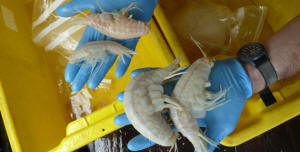|
Unique Cruise Solutions The news you need to know |
|||||||||||||||||
|
|||||||||||||||||
 |
|
|
|||||||||||||||
|
Cruise News for the Corporate Travel Professional |
|||||||||||||||||
|
British scientists have made a stunning discovery, finding ‘supergiant’ amphipods 10 times the size of normal specimens. |
||||||||||||||||
The prawn-like crustaceans usually measure 2 to 3 centimetres
long but a joint UK-New Zealand expedition managed to pull up specimens coming
to 28cm, with a mammoth 34cm amphipod also captured on film. The
creepy crawlies were nabbed in depths of up to 9,990 metres by a huge metal trap
attached with a camera – technology devised by the University of Aberdeen’s
Oceanlab. The
creepy crawlies were nabbed in depths of up to 9,990 metres by a huge metal trap
attached with a camera – technology devised by the University of Aberdeen’s
Oceanlab.
The astounding find was inadvertently made as the expedition
attempted to find deep sea snailfish in the Kermadec Trent, north of New Zealand
– specimens that have not been caught for over 60 years. |
|||||||||||||||||
|
|
|||||||||||||||||
|
|
|||||||||||||||||
|
|
|||||||||||||||||
|
Worldwide Travel & Cruise Assoc., Inc. 150 S. University Dr. Ste E, Plantation, FL 33324 - USA Tel: +1 954 452 8800 Fax: +1 954 252 3945 EMail: sales@cruiseco.com |
|||||||||||||||||
|
Designed & Published by: Worldwide Media. |
|||||||||||||||||




